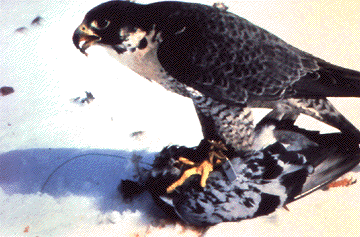Peregrines are still threatened by chemicals

By Jeff Barnard
Associated Press Writer
MEDFORD, Ore. -- Jeep Pagel rappelled down a spectacular rock cliff
to a ledge harboring two peregrine falcon chicks, pulled on a
surgical glove and gathered up broken eggshells.
"A toxicologist told me, 'Don't touch the eggs. They're loaded
with organochlorine contaminants,"' the U.S. Forest Service
biologist said afterward.
More than 20 years after DDT was banned in the United States
and the peregrine falcon was put on the endangered species list,
the deadly pesticide still is causing problems for the bird.
DDT, ingested by the falcons through the birds they prey on,
has long been blamed for eggs with shells so thin they often crack
before they can hatch.
Now Pagel is wondering whether DDT or other chemicals are
responsible for an unnatural 2-to-1 proportion of females to males
among newborn chicks and whether they are also causing at least
one male to act like a female.
"With these contaminants introduced into the system since the
1940s, I may never have seen normal peregrine behavior," he said.
DDT came into wide use during World War II to control insects
such as lice and mosquitoes. Through the 1950s and '60s, it was
widely used to control crop-eating insects.
But when scientists discovered that birds such as the
peregrine and the bald eagle were ingesting the pesticide, and
were unable to hatch young because of eggshell thinning, DDT was
virtually banned in the United States in 1972.
The bald eagle has recovered enough that the government is
taking it off the endangered species list and listing it instead
as a threatened species.
The effects of DDT in wildlife have been dissipating as the
chemical gets buried in the sediment of rivers and bays, said D.
Michael Fry, a research physiologist at the University of
California at Davis.
But storms and dredging stir it up from time to time. And the
pesticide still is used in Central America and other parts of the
world, where it contaminates migratory birds. In warm weather, it
becomes volatile and is carried up into the atmosphere, falling
around the world in rain.
"We see it in the snow and ice of Antarctica, as well as the
Arctic," Fry said. "I think the problems with DDT are much reduced
in the temperate zones, but it will continue to pose a global risk
if it is used in other parts of the world."
Patricia Zenone, a U.S. Fish and Wildlife Service biologist in
Reno, Nev., is analyzing a proposal to upgrade peregrines in the
West from endangered to threatened species. After the 1992
breeding season, Western states counted 591 breeding pairs,
compared with estimates of fewer than 50 in 1973.
Still, peregrines in southwestern Oregon, the California coast
near Big Sur and western Texas have problems.
Pagel, who keeps watch over 37 nests in Oregon and Northern
California, counted an average of one chick per nest. That's
better than the 0.7 in recent years but still below the 1.5 needed
to maintain a stable population.
Zenone believes peregrines are contaminated by DDT from
migrating to Mexico and Central America and from eating birds in
this country that have been south of the border.
Pagel thinks the sources of contamination may be closer to
home, in forests that were sprayed for years with chemicals to
control weeds and pests.
He is finding that peregrines in Oregon that nest below 2,000
feet don't travel very far or eat migratory birds in winter. And
it is in winter that the falcons form their fat reserves, where
DDT is stored.
Pagel also found that in one nest in Oregon, the male is
failing to feed his mate when she is brooding and is trying to
bump her off the eggs.
"It's like there's two females in the nest," Pagel said.
DDT and other chemicals, such as PCBs, mimic the female
hormone estrogen, causing malformed male sex organs in species
from sea gulls to alligators.
"We banned DDT basically because of its eggshell thinning
effects," Fry said. "Its feminizing effects, although reported 13
years ago, really have not been of great interest until the last
couple of years. But I think there's much more danger to wildlife
than just eggshell thinning."
Nobody knows what is skewing the sex ratio among peregrines.
Fry said he doubts it's DDT, and Pagel suggested it also could be
other unknown or unmeasurable contaminants.
Back to the top
Back to the front page
�

